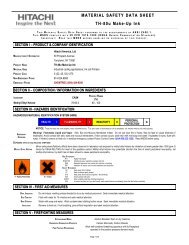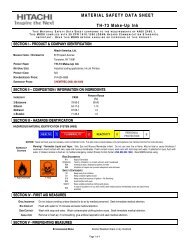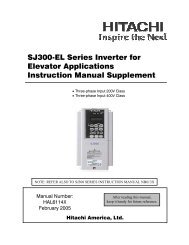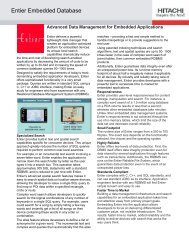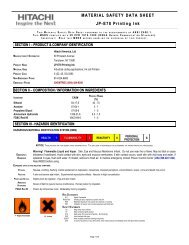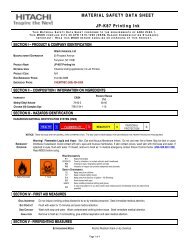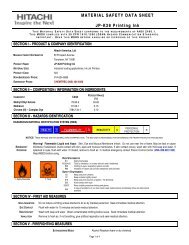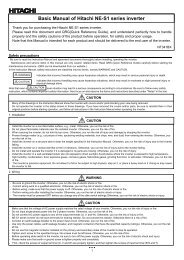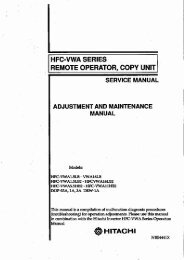SJ700-2 Instruction Manual NT204DX - Hitachi America, Ltd.
SJ700-2 Instruction Manual NT204DX - Hitachi America, Ltd.
SJ700-2 Instruction Manual NT204DX - Hitachi America, Ltd.
You also want an ePaper? Increase the reach of your titles
YUMPU automatically turns print PDFs into web optimized ePapers that Google loves.
Chapter 2 Installation and Wiring<br />
Digital (contact)<br />
Analog<br />
Analog input Relay contact output Open collector output Contact input<br />
Function selection<br />
and logic switching<br />
Status and factor<br />
Status and alarm<br />
Sensor<br />
Symbol Terminal name Description Electric property<br />
To switch the control logic between sink logic and source logic, change the<br />
jumper connection of this (PLC) terminal to another terminal on the control<br />
PLC<br />
circuit terminal block.<br />
Intelligent input<br />
Jumper terminals P24 and PLC for the sink logic; jumper terminals CM1<br />
(common)<br />
and PLC for the sink logic.<br />
To use an external power supply to drive the contact inputs, remove the<br />
jumper, and connect the PLC terminal to the external interface circuit.<br />
11<br />
12<br />
13<br />
14<br />
15<br />
CM2<br />
AL0<br />
AL1<br />
AL2<br />
TH<br />
Intelligent output<br />
Intelligent output<br />
(common)<br />
Intelligent relay<br />
output<br />
External<br />
thermistor input<br />
Select five of a total 51 functions, and assign these five functions to<br />
terminals 11 to 15.<br />
If you have selected an alarm code using the function "C062", terminals 11<br />
to 13 or 11 to 14 are used exclusively for the output of cause code for alarm<br />
(e.g., inverter trip). The control logic between each of these terminals and<br />
the CM2 terminal always follows the sink or source logic.<br />
This terminal serves as the common terminal for intelligent output terminals<br />
[11] to [15].<br />
Select functions from the 43 available, and assign the selected functions to<br />
these terminals, which serve as C contact output terminals.<br />
In the initial setting, these terminals output an alarm indicating that the<br />
inverter protection function has operated to stop inverter output.<br />
Connect to an external thermistor to make the inverter trip if an abnormal<br />
temperature is detected.<br />
The CM1 terminal serves as the common terminal for this terminal.<br />
[Recommended thermistor properties]<br />
Allowable rated power: 100 mW or more<br />
Impedance at temperature error: 3kΩ<br />
The impedance to detect temperature errors can be adjusted within the<br />
range 0Ω to 9,999Ω.<br />
Voltage drop between each<br />
terminal and CM2 when<br />
output signal is on: 4 V or<br />
less<br />
Maximum allowable<br />
voltage: 27 VDC<br />
Maximum allowable<br />
current: 50 mA<br />
(Maximum contact<br />
capacity)<br />
AL1-AL0: 250 VAC, 2 A<br />
(resistance) or 0.2 A<br />
(inductive load)<br />
AL2-AL0: 250 VAC, 1 A<br />
(resistance) or 0.2 A<br />
(inductive load)<br />
(Minimum contact capacity)<br />
100 VAC, 10 mA<br />
5 VDC, 100 mA<br />
Allowable range of input<br />
voltages<br />
0 to 8 VDC<br />
[Input circuit]<br />
DC8V<br />
10kΩ<br />
TH<br />
Thermistor 1kΩ<br />
CM1<br />
(3) Explanation of switch settings<br />
The internal slide switch (SW1) is used to enable or disable the emergency stop function (the function<br />
is disabled by factory setting).<br />
* For the location of the slide switch, see page 2-9.<br />
2 - 8




